
Ace Combat 04: Shattered Skies is a 2001 combat flight simulation video game developed and published by Namco for the PlayStation 2. It is the fourth entry in the Ace Combat series and the first in the series to be released for the PlayStation 2. The game's plot, set in a fictional alternate universe where Earth has been ravaged by asteroid impacts, follows the player character "Mobius 1", a fighter pilot in a multinational military coalition who spearheads the liberation of the fictional continent of Usea from the expansionist country of Erusea.
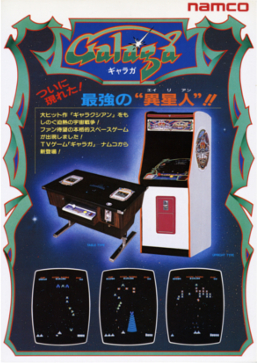
Galaga is a 1981 fixed shooter video game developed and published by Namco for arcades. In North America, it was released by Midway Manufacturing. It is the sequel to Galaxian (1979), Namco's first major video game hit in arcades. Controlling a starship, the player is tasked with destroying the Galaga forces in each stage while avoiding enemies and projectiles. Some enemies can capture a player's ship via a tractor beam, which can be rescued to transform the player into a "dual fighter" with additional firepower.

Time Crisis II is a 1997 light-gun shooter video game developed and published by Namco for arcades. It is the second installment in the Time Crisis series. The game incorporates the same mechanics of its predecessor, with some minor changes, but with the addition of co-operative two-player gaming. The game's story focuses on the efforts of two secret agents, Keith Martin and Robert Baxter, as they attempt to thwart the efforts of an industry mogul's plan for world dominance.

Battle City is a 1985 multi-directional shooter video game developed and published by Namco for the Family Computer. It is a successor to Namco's 1980 Tank Battalion, and would be succeeded itself by the 1991 Tank Force.

Twinkle Star Sprites is a competitive vertically scrolling shooter arcade video game created by ADK and published by SNK in 1996. It was ADK's last production for the Neo Geo. Two players are each in separate, side-by-side, vertically scrolling levels. Combinations of shots and timed power-ups damage the other player. These attacks also serve as counters to the opponent's attack.
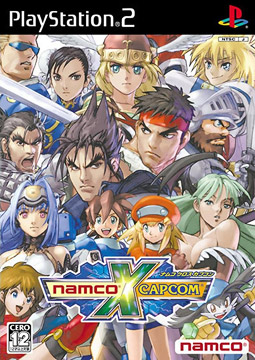
Namco × Capcom is a tactical role-playing (RPG) crossover video game developed by Monolith Soft for the PlayStation 2 and published by Namco in 2005. The gameplay combines tactical RPG and action sequences during battles, featuring characters from video game series owned by Namco and Capcom. The narrative sees original characters Reiji Arisu and Xiaomu, operatives for paranormal investigative group Shinra, confront distortions bringing characters from other realities into their own.
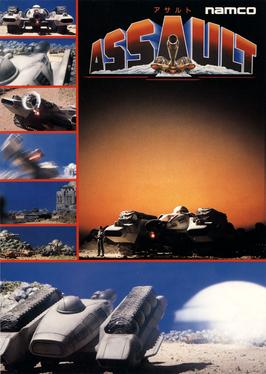
Assault is a 1988 multi-directional shooter arcade game developed and published by Namco. It was licensed to Atari Games for release in North America. Controlling a caterpillar-tread self-propelled gun, the player is tasked with completing each of the game's eleven stages while shooting enemies and avoiding projectiles. It uses a twin-stick control layout, similar to games such as Battlezone. The plot involves the human race searching for new planets after Earth reaches its maximum population - after discovering an exo-planet 35,000 light years away from the Milky Way, they enslave the planet's natives and take control, leading to the planet's native population vowing to abolish the humans and bring peace to their world. The protagonist who rides the aforementioned self-propelled gun which players control, is one such native.
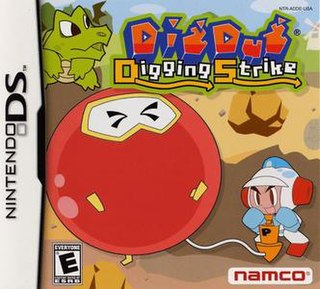
Dig Dug: Digging Strike is a 2005 maze video game published by Namco for the Nintendo DS. In Europe, the game was published by Atari Europe. It is the fifth entry in the Dig Dug video game series, and the second to be made for a home platform. The game follows series protagonist Taizo Hori, bitter about his son Susumu getting more attention than him—after a chain of tropical islands is threatened by monsters, Taizo sets out to defeat them and reclaim his fame. Gameplay combines mechanics established in the original Dig Dug and its sequel Dig Dug II, centered around sinking a large "boss" character into the ocean by digging under large stakes in the ground.

Klonoa: Moonlight Museum is a video game developed by Namco and published by Bandai, released in Japan for the WonderSwan in 1999. It is the first handheld game in the Klonoa series to place him in a fully two-dimensional world, and established the system that the Game Boy Advance titles later used.

Dragon Spirit is a 1987 vertical-scrolling shooter arcade game developed and published by Namco. In North America, it was distributed by Atari Games. Controlling the dragon Amur, the player must complete each of the game's nine areas to rescue the princess Alicia from the demon Zawell. Similar to Namco's own Xevious, Amur has a projectile weapon for destroying air-based enemies and a bomb for destroying ground enemies. It ran on the Namco System 1 arcade board.
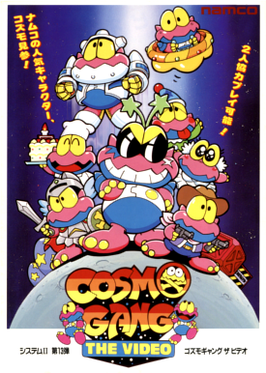
Cosmo Gang the Video is a 1992 fixed shooter arcade game developed and published by Namco. A home conversion for the Super Famicom was released the same year. Controlling the Hyper Beat starship, the player is tasked with ridding the galaxy of the Cosmo Gang, a race of aliens that cause mischief across Earth. Gameplay involves shooting enemies and avoiding projectiles. Power-up items can be collected to grant the player additional abilities. It ran on the Namco System 2 arcade board.

Xevious 3D/G is a 1996 vertically scrolling shooter video game developed and published by Namco for arcades. The eighth entry in the Xevious series, it combines 2D-based gameplay with 3D gouraud-shaded polygon graphics. Players control the Solvalou starship in its mission to destroy a rogue supercomputer named GAMP and the Xevian Forces, using two basic weapon types: an air zapper to destroy air targets, and a blaster bomb to destroy ground targets. The game also features destructive power-ups, new bosses, and two player simultaneous play.

Wild Arms 5, released in Japan as Wild Arms: The Fifth Vanguard, is a role-playing video game developed by Media.Vision and published by Sony Computer Entertainment for the PlayStation 2. It is the fifth and most recent main installment of the Wild Arms series. It was released in December 2006 in Japan, August 2007 in North America by Xseed Games, February 2008 in Europe by 505 Games and April 2008 in Australia by Xseed Games. The game celebrates the series' 10th anniversary by featuring cameo appearances of characters from the previous games.

Time Crisis: Project Titan is a 2001 light-gun shooter video game developed by Namco and Flying Tiger Entertainment and published by Namco for the PlayStation. It is a spin-off of Namco's Time Crisis series, serving as a direct sequel to the PlayStation port of the original Time Crisis.

Soldier Blade is a 1992 vertically scrolling shooter developed and published by Hudson Soft for the TurboGrafx-16. Controlling the titular starship, the player is tasked with completing each of the game's seven stages in order to wipe out the Zeograd Army, an alien race bent on conquering Earth. The game is the fourth entry in the Star Soldier series and shares many similarities with its predecessor Super Star Soldier, with Soldier Blade having a heavy emphasis on speed.

Star Trigon is a 2002 puzzle arcade game published in Japan by Namco. Ports for iPod, iOS devices and Windows were also released. In the game, the player controls one of three characters — Wataru Hoshi, Chuta Bigbang and Susumu Hori — the objective being to rescue creatures known as "Uchijins" by hopping from planet to planet to draw triangles and capture them. The player will automatically circle the planet they are on, requiring timed jumps to avoid falling off the playfield. It ran on the Namco System 10 hardware.
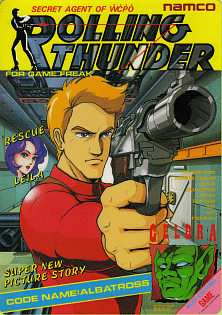
Rolling Thunder is a run and gun video game developed by Namco in Japan and Europe and released in 1986 as a coin-operated arcade video game using the Namco System 86 hardware. It was distributed in North America by Atari Games. The player takes control of a secret agent who must rescue his female partner from a terrorist organization. Rolling Thunder was a commercial success in arcades, and it was released for various home computer platforms in 1987 and the Nintendo Entertainment System in 1989. The original arcade game has been included in various classic game compilations as well. It influenced later arcade action franchises such as Shinobi and Time Crisis, which borrowed mechanics such as taking cover behind crates. On March 17, 2022, the arcade version of the game got ported as part of the Arcade Archives series.
Let's! TV Play Classic is a series of Japan-only plug & play devices developed and distributed by Bandai programmed on XaviX software created by SSD Company Limited in 2006 that contain arcade games from either Namco or Taito, with Namco's being called "Namco Nostalgia" while Taito's are called "Taito Nostalgia". Each device in the series contains 4 games, with 2 being classic arcade games while the other 2 are new games using the original game's sprites developed by Bandai.

Galaga '91 is a 1991 fixed shooter video game developed and published by Namco for the Game Gear. It was published by Sega in Europe and renamed Galaga 2. The first portable installment in the Galaxian series, players control a lone starfighter in its mission to eradicate the hostile Galaga forces before they take over Earth. Gameplay revolves around shooting down formations of enemies and avoiding their projectiles.

Ghoul Panic is a 1999 light gun shooter video game developed by Raizing and published by Namco for arcades. A version for the PlayStation was released in 2000. Players used lightguns to complete a series of minigames, done by firing at on-screen targets. In these minigames there is an objective that must be fulfilled before the time runs out to progress such as shooting a certain amount of enemies or protecting small, yellow cats from projectiles. It ran on the Namco System 12 arcade hardware.

















